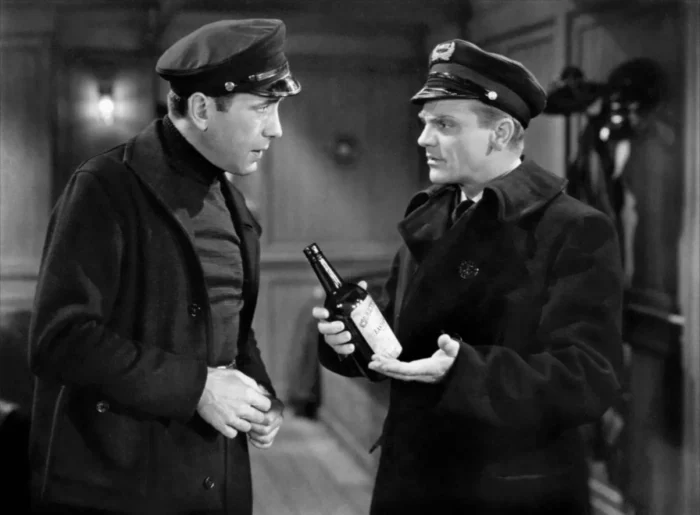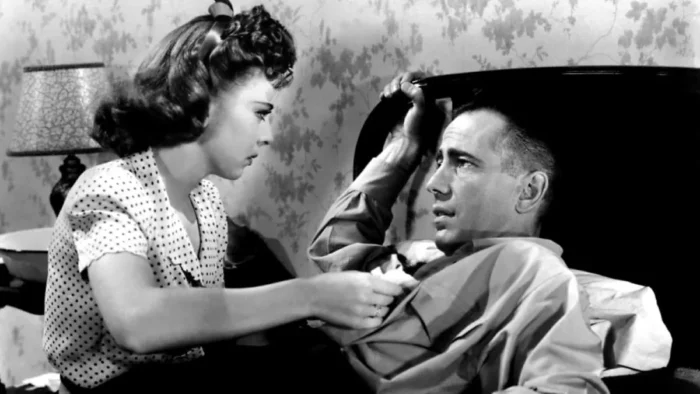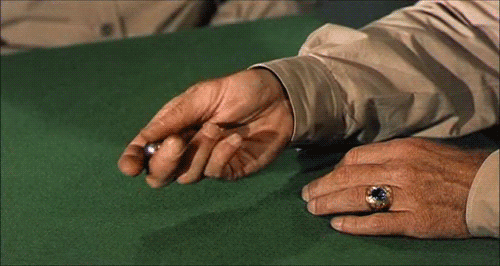
What an unlikely movie star, on the face of it. He was short and balding. He had a slight speech impediment. He was not classically good-looking in a smooth and/or accessible way. He got his start playing heavies. Gangsters and bad guys. Pre-Code prohibition-era crime movies. He usually was shot dead. Nobody felt bad about it. Stardom was not in the cards. He was a working actor. He had a “look”. Then came The Petrified Forest on Broadway.

Bogart on the far left, five o’clock shadow visible from the cheap seats.
It’s not an overstatement to say Bogart caused an absolute sensation with his performance. It was not Bogart’s debut. He had played small parts on Broadway before, but his reputation early on – if you can believe it – was as the youth sashaying into the parlor saying things like, “Tennis, anyone?” He played pampered prep-school boys. Fascinating. He was not unknown to Broadway audiences, and so nothing could prepare New York for Petrified Forest. This was a theme in Bogart’s life: the shifting personality, the experimentation with his strengths, finding what would “hit” an audience, and the public’s perception changing as he took on deeper and better parts. It’s hard to imagine Bogart saying, “Tennis, anyone?” now.
Petrified Forest launched him into the realm of serious Hollywood players (because, of course, the Broadway production was turned into a film). The character of Duke Mantee was a psychopath. In the film, Bogart seems like an emissary from the future, if you compare to how other “villains” were played at that time. Duke is irredeemable, but you can’t take your eyes off of him. Bogart worked hard on that part, creating Duke from the ground up – how he walked, how he talked, how he DIDN’T talk, Duke’s body language, gestures. Everything had to be perfect.

Bogart in the film of The Petrified Foest
After Petrified Forest, he played heavies. Can we count the number of times he was killed by Edward G. Robinson? He played sidekicks, like in The Roaring Twenties, with James Cagney as the lead. (The phrase “Don’t bogart the joint” – while obviously referring to Bogart’s ubiquitous cigarette – also seems to me to have as its reference the foxhole scene in Roaring Twenties, when Bogart hogs the shared cigarette).

Humphrey Bogart and James Cagney in “The Roaring Twenties”
Bogart did not move on to play leading roles after Petrified Forest. He was second lead. He was in movies with names like San Quentin, King of the Underworld, You Can’t Get Away With Murder, Racket Busters, Crime School – typical Warner Brothers “ripped from the headlines” fare. He was shot in shabby 1920s hotel rooms, he staggered to the couch, he fell down the stairs. He was a bootlegger, a conman, a thief. He was also, incidentally, expendable. We might cry when Cagney died, but we didn’t care when Bogart died.
It’s interesting to watchthese “in between” movies in the decade of the 30s, like Bullets or Ballots and others, when Bogart plays second-banana. It helps underline what might not be obvious: his giant mythic stardom was NOT guaranteed, or obvious. He was not being groomed for it, and it was not what the public wanted from him. His Duke Mantee made such a huge impression: Bogart could have had a whole career playing villains and hypnotic bad guys … but look at what happened! Look at how things shifted! Amazing!
A couple of parts paved the way for Casablanca.
In High Sierra, he plays Roy Earle, another villain, with a crucial difference in shading. In High Sierra, his criminal has a soft underbelly, a hidden tenderness. You rooted for him (in a way you did NOT root for Duke Mantee). John Huston wrote the screenplay for High Sierra (and the same year was given his first directing opportunity, The Maltese Falcon. Bogart, having already gotten to know Huston on High Sierra, decided to take a chance with the untried director, which Huston appreciated). Roy Earle in High Sierra is one of Bogart’s best roles, and it’s important as a transition in his career: we can see the other persona, the one we all now know, start to be developed: the wry-faced cynical guy, but with a mother-lode of moral character within. A crucial Bogart VIBE is his characters don’t want to be congratulated for his moral character: he’d rather you not notice it at all. In this way, Bogart resists sentimentality.

Ida Lupino and Humphrey Bogart in “High Sierra”
In High Sierra, Roy ends up doing the right thing, even though it means he’ll lose the girl. Such a departure from Duke Mantee! I love to look at a career and see fortuitous turns, turns it didn’t HAVE to take. Katharine Hepburn was a star leading lady immediately. It was instantly apparent she could never play a sidekick. As weird as she was, she had to be center stage. It was different with Bogart. You get the sense with Bogart that it might NOT have happened. Bogart was not an obvious movie star and his journey is full of accidents, coincidences, and giant leaps of faith.

His Sam Spade in The Maltese Falcon solidified his position as a valid leading man, which really worked since the story was a noir, and so his tough-ness could still operate. Whatever softness Bogart had was expressed in spite of himself and that really works for him.
The roles Bogart got after Maltese Falcon were after America’s entry into the war in Europe: Across the Pacific and Casablanca … he was now a valid lead, and one of the most compelling movie stars working at the time.

Humphrey Bogart in “The Caine Mutiny”
Later in his career, he could “experiment”, in films like The Caine Mutiny and The African Queen, not to mention the mighty In a Lonely Place. You could see it in Treasure of the Sierra Madre too. He was so good when he was close to madness, or tipping right over into paranoia, mania, greed – or, In a Lonely Place – a scary obsessed stalker. In a Lonely Place is his very best. He has a moment where he lashes out and knocks the glasses off of his agent’s face and it is painful to watch.

Gloria Grahame and Humphrey Bogart in “In a Lonely Place”
Here’s an excerpt from Nathaniel Benchley’s Humphrey Bogart about Bogart’s performance on Broadway in Petrified Forest: (KUDOS are due Leslie Howard, as is obvious in this excerpt):
When Humphrey Bogart walked onstage as Duke Mantee there was a stir in the audience, an audible intake of breath. He was a criminal; he walked with a convict’s shuffling gait, and his hands dangled in front of him as though held there by the memory of manacles. His voice was flat and his eyes were as cold as a snake’s; he bore an eerie resemblance to John Dillinger, to whom killing a person meant no more than breaking a matchstick. Sherwood’s summary of Mantee in the stage directions described Bogart perfectly: “He is well-built but stoop-sholudered, with a vaguely thoughtful, saturnine face. He is about thirty-five, and, if he hadn’t elected to take up banditry, he might have been a fine leftfielder. There is, about him, one quality of resemblance to Alan Squier [the hero]: he too is unmistakably doomed.”
The play opened at the Broadhurts Theatre on January 7, 1935, with Leslie Howard starring as Alan Squier and Peggy Conklin as Gabrielle Maple, the heroine. (For those interested in trivia, the part of Boze Hertzlinger, which had almost been Humphrey’s, was played by a youth named Frank Milan.) …
The critics threw their hats in the air. Brooks Atkinson wrote that “Robert Sherwood’s new play is a peach … a roaring Western melodrama … Humphrey Bogart does the best work of his career as the motorized guerrilla,” and Robert Garland said that “Humphrey Bogart is gangster Mantee to the tip of his sawed-off shotgun.” The play, clearly, was in for a long run…
Once rehearsals were under way, Humphrey … concentrated on becoming as convincing a gangster as possible. He walked, talked, and lived Duke Mantee; he wore a felt hat with the brim turned down, he talked out of the side of his mouth, and he built a set of mannerisms to go with the character. There are very few shows that don’t have some sort of trouble or conflict prior to (and sometimes after) opening night, but Hopkins had chosen his cast well. A short, round, brown, slightly bowlegged little man, he quietly mesmerized the actors into doing what he wanted, and since in many instances he had intuitively cast them against type (as in Bogart’s case) the results were often electric. He told them that he collected casts the way other people collect books, and that this was the perfect cast; there was not one person in it he’d think of changing…
Their first night in front of an audience was in mid-December at the Parsons Theatre in Hartford, and there were two things that astonished the company. One was the amount of humor in the script – lines took on a new meaning, which they’d missed in rehearsal – and the other was the literal gasp that went up when Humphrey made his entrance. Dillinger was very much in the news at the time, having recently escaped from prison, and to some people it seemed that he had just walked onstage. The prison pallor, the two-day’s beard, the gait, the mannerisms – everything about him was menacing, evil, and real. The company was to hear that gasp every night throughout the run, but the first one was the one they still remember. They went on to Boston, where they opened Christmas Eve, and then to New York in January. They played until June 29 of that year.
For two reasons, Humphrey disdained the use of makeup. The first was that the desired effect of prison pallor made makeup unnecessary, and the second was that to fake a two-days’ beard would be obvious. His was his real beard, and he kept it trimmed during the week with electric clippers, thereby becoming one of the earlier electric shavers. After the Saturday night performance he would shave, singing and lathering himself and having a grand old time, and he would come into Miss Leeming’s dressing room, which adjoined his, and spread his good cheer around with a lavish hand. She remembers him as being generally quiet and gentle, and scrupulous in his behavior to the female members of the cast – a trait that was by no means shared by the star.
The play could have run for a much longer time, but Howard grew weary of playing it. He had enough muscle with the producers (he was a coproducer with Gilbert Miller, in association with Hopkins) so that he could forbid anyone else to take his part, and also to prevent its going on the road. Warners had by this time bought it, and Howard announced that a road tour might hurt the box office for the picture. So they closed the end of June, while still doing booming business; Howard went home to England, and the others went looking for jobs…
One of the good things Howard did, however, was to say that he would do the picture only if Bogart played Mantee, and he was as good as his word. Warners had Edward G. Robinson under contract, and saw no sense in using someone they’d already had a few unspectacular dealings with, so they blithely announced they were making the picture with Howard and Robinson, and with Bette Davis playing Gabrielle. Humphrey, understandably upset, cabled the news to Howard, and Howard cabled Warners that without Bogart he wouldn’t play. They gave in, and Humphrey was signed to another Warner Brothers contract.

Thank you so much for stopping by. If you like what I do, and if you feel inclined to support my work, here’s a link to my Venmo account. And I’ve launched a Substack, Sheila Variations 2.0, if you’d like to subscribe.



